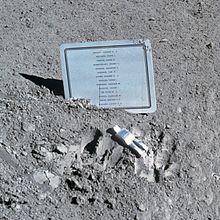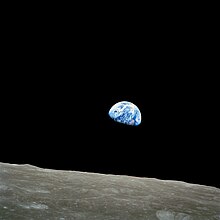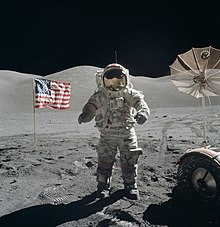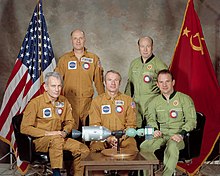Disaster strikes both sides
In 1967, both nations faced serious challenges that brought their programs to temporary halts. Both had been rushing at full-speed toward the first piloted flights of Apollo and Soyuz, without paying due diligence to growing design and manufacturing problems. The results proved fatal to both pioneering crews. |
Charred interior of the Apollo 1 spacecraft after the fire that killed the first crew |
Commemorative plaque and the "Fallen Astronaut" sculpture left on the Moon in 1971 by the crew of Apollo 15 in memory of 14 deceased NASA astronauts and USSR cosmonauts |
Onward to the Moon
The United States recovered from the Apollo 1 fire, fixing the fatal flaws in an improved version of the Block II command module. The US proceeded with unpiloted test launches of the Saturn V launch vehicle (Apollo 4 and Apollo 6) and the Lunar Module (Apollo 5) during the latter half of 1967 and early 1968. Apollo 1's mission to check out the Apollo Command/Service Module in Earth orbit was accomplished by Grissom's backup crew commanded by Walter Schirra on Apollo 7, launched on October 11, 1968. The eleven-day mission was a total success, as the spacecraft performed a virtually flawless mission, paving the way for the United States to continue with its lunar mission schedule.Artist view of Soyuz 4 and Soyuz 5 after docking |
Soyuz 7K-L1 Zond spacecraft. Artist view |
Earthrise as seen from Apollo 8, December 24, 1968 (NASA) |
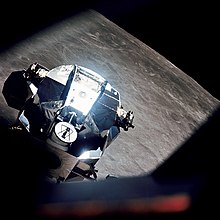 |
The Lunar Module flew in lunar orbit on Apollo 10, May 22–23, 1969 |
The American Lunar Module was finally ready for a successful piloted test flight in low Earth orbit on Apollo 9 in March 1969. The next mission, Apollo 10, conducted a "dress rehearsal" for the first landing in May 1969, flying the LM in lunar orbit as close as 47,400 feet (14.4 km) above the surface, the point where the powered descent to the surface would begin. With the LM proven to work well, the next step was to attempt the landing.
Unknown to the Americans, the Soviet Moon program was in deep trouble. After two successive launch failures of the N1 rocket in 1969, Soviet plans for a piloted landing suffered delay. The launch pad explosion of the N-1 on July 3, 1969 was a significant setback. The rocket hit the pad after an engine shutdown, destroying itself and the launch facility. Without the N-1 rocket, the USSR could not send a large enough payload to the Moon to land a human and return him safely.
Apollo 11
American Buzz Aldrin during the first Moon walk in 1969 |
The trip to the Moon took just over three days. After achieving orbit, Armstrong and Aldrin transferred into the Lunar Module, named Eagle, and after a landing gear inspection by Collins remaining in the Command/Service Module Columbia, began their descent. After overcoming several computer overload alarms caused by an antenna switch left in the wrong position, and a slight downrange error, Armstrong took over manual flight control at about 180 meters (590 ft), and guided the Lunar Module to a safe landing spot at 20:18:04 UTC, July 20, 1969 (3:17:04 pm CDT). The first humans on the Moon waited six hours before they left their craft. At 02:56 UTC, July 21 (9:56 pm CDT July 20), Armstrong became the first human to set foot on the Moon.
The first step was witnessed by at least one-fifth of the population of Earth, or about 723 million people. His first words when he stepped off the LM's landing footpad were, "That's one small step for [a] man, one giant leap for mankind." Aldrin joined him on the surface almost 20 minutes later. Altogether, they spent just under two and one-quarter hours outside their craft. The next day, they performed the first launch from another celestial body, and rendezvoused back with Columbia.
Apollo 11 left lunar orbit and returned to Earth, landing safely in the Pacific Ocean on July 24, 1969. When the spacecraft splashed down, 2,982 days had passed since Kennedy's commitment to landing a man on the Moon and returning him safely to the Earth before the end of the decade; the mission was completed with 161 days to spare With the safe completion of the Apollo 11 mission, the Americans won the race to the Moon.
The race winds down
Apollo 17's Saturn V in 1972 |
Moonwalk, December 13, 1972 |
The first landing was followed by another, precision landing on Apollo 12 in November 1969. NASA had achieved its first landing goal with enough Apollo spacecraft and Saturn V launchers left for eight follow-on lunar landings through Apollo 20, conducting extended-endurance missions and transporting the landing crews in Lunar Roving Vehicles on the last five. They also planned an Apollo Applications Program to develop a longer-duration Earth orbital workshop (later named Skylab) to be constructed in orbit from a spent S-IVB upper stage, using several launches of the smaller Saturn IB launch vehicle. But planners soon decided this could be done more efficiently by using the two live stages of a Saturn V to launch the workshop pre-fabricated from an S-IVB (which was also the Saturn V third stage), which immediately removed Apollo 20. Belt-tightening budget cuts soon led NASA to cut Apollo 18 and 19 as well, but keep three extended/Lunar Rover missions. Apollo 13 encountered an in-flight spacecraft failure and had to abort its lunar landing in April 1970, returning its crew safely but temporarily grounding the program again. It resumed with four successful landings on Apollo 14 (February 1971), Apollo 15 (July 1971), Apollo 16 (April 1972), and Apollo 17 (December 1972).
In February 1969, President Richard M. Nixon convened a Space Task Group to set recommendations for the future US civilian space program, headed by his Vice President Spiro T. Agnew. Agnew was an enthusiastic proponent of NASA's follow-on plans, and the STG recommended plans to develop a reusable Space Transportation System including a Space Shuttle, which would facilitate development of permanent space stations in Earth and lunar orbit, perhaps a base on the lunar surface, and the first human flight to Mars as early as 1986 or as late as 2000. Nixon had a better sense of the declining political support in Congress for a new Apollo-style program, which had disappeared with the achievement of the landing, and he intended to pursue detente with the USSR and China, which he hoped might ease Cold War tensions. He cut the spending proposal he sent to Congress to include funding for only the Space Shuttle, with perhaps an option to pursue the Earth orbital space station for the foreseeable future.
The USSR continued trying to perfect their N1 rocket, finally canceling it in 1976, after two more launch failures in 1971 and 1972.
Salyuts and Skylab
The Soyuz 11 crew with the Salyut station in the background, in a Soviet commemorative stamp |
Salyut 1's orbit was increased to prevent premature reentry, but further piloted flights were delayed while the Soyuz was redesigned to fix the new safety problem. The station re-entered the Earth's atmosphere on October 11, after 175 days in orbit. The USSR attempted to launch a second Salyut-class station designated Durable Orbital Station-2 (DOS-2) on July 29, 1972, but a rocket failure caused it to fail to achieve orbit. After the DOS-2 failure, the USSR attempted to launch four more Salyut-class stations up to 1975, with another failure due to an explosion of the final rocket stage, which punctured the station with shrapnel so that it would not hold pressure. All of the Salyuts were presented to the public as non-military scientific laboratories, but some of them were covers for the military Almaz reconnaissance stations.
The United States launched the orbital workstation Skylab 1 on May 14, 1973. It weighed 169,950 pounds (77,090 kg), was 58 feet (18 m) long by 21.7 feet (6.6 m) in diameter, with a habitable volume of 10,000 cubic feet (280 m3). Skylab was damaged during the ascent to orbit, losing one of its solar panels and a meteoroid thermal shield. Subsequent manned missions repaired the station, and the final mission's crew, Skylab 4, set the Space Race endurance record with 84 days in orbit when the mission ended on February 8, 1974. Skylab stayed in orbit another five years before reentering the Earth's atmosphere over the Indian Ocean and Western Australia on July 11, 1979.
Apollo–Soyuz Test Project
Apollo-Soyuz crew: From left to right: Donald "Deke" Slayton, Thomas Patten Stafford, Vance Brand, Alexey Leonov, and Valeri Kubasov |
The two nations planned a joint mission to dock the last US Apollo craft with a Soyuz, known as the Apollo-Soyuz Test Project (ASTP). To prepare, the US designed a docking module for the Apollo that was compatible with the Soviet docking system, which allowed any of their craft to dock with any other (e.g. Soyuz/Soyuz as well as Soyuz/Salyut). The module was also necessary as an airlock to allow the men to visit each other's craft, which had incompatible cabin atmospheres. The USSR used the Soyuz 16 mission in December 1974 to prepare for ASTP.
The joint mission began when Soyuz 19 was first launched on July 15, 1975 at 12:20 UTC, and the Apollo craft was launched with the docking module six and a half hours later. The two craft rendezvoused and docked on July 17 at 16:19 UTC. The three astronauts conducted joint experiments with the two cosmonauts, and the crew shook hands, exchanged gifts, and visited each other's craft.
Legacy
Human spaceflight after Apollo
International Space Station in 2010 |
The Russian R-7 rocket family, which launched the first Sputnik at the beginning of the space race, is still in use today. It services the International Space Station (ISS) as the launcher for both the Soyuz and Progress spacecraft. It also ferries both Russian and American crews to and from the station.
